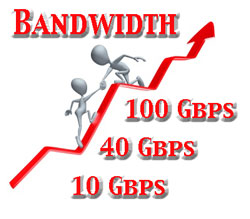Over the past year, major telecom companies have been upgrading their core networks from 40 Gbps to 100 Gbps. Comcast recently joined this trend by incorporating Ciena’s Wave Logic 3 interfaces into their existing Ciena 6500 packet optical platforms. This begs the question: why would a cable company make this change, and how can it benefit your business?
Comcast is widely recognized as a Cable TV provider, or MSO (Multi-System Operator). They provide video television, high-speed internet, and telephone services to over 20 million residential and commercial customers across 40 states and the District of Columbia. Comcast broadband is popular for homes, home offices, and small businesses due to its affordability and coaxial cable delivery. However, many are unaware that Comcast operates one of the largest fiber optic networks in the United States behind the scenes.
It’s a common misconception that cable companies still rely solely on coaxial cables of varying sizes to connect everything from their head-end towers and satellite dishes to locations around town. While true in the early days of analog TV cable systems and master antennas for large apartment buildings, technology has evolved. Today, everything is digital, with signals traveling primarily through fiber optic cables until reaching your location. The final connection from the curb to your building remains RG-6 coaxial copper wire.
This is because it functions adequately, and the installation cost has already been accounted for. DOCSIS 3.0 modems provide broadband internet speeds exceeding 100 Mbps, which is sufficient for most users. Residential, home office, and very small business users prioritize low monthly costs combined with satisfactory performance. The shared asymmetrical bandwidth (higher download than upload speeds) and “best effort” performance are more than enough for internet access, document downloads, and streaming pictures and videos.
However, HFC (Hybrid Fiber Cable) services fall short when high bandwidth, dedicated low latency service, symmetrical upload and download speeds, and an SLA (Service Level Agreement) are required. These features are characteristic of traditional telecom services like T1, DS3, and SONET fiber, as well as newer Ethernet services such as FastE at 100 Mbps, GigE at 1000 Mbps, and 10 GigE at 10 Gbps.
What many people don’t realize is that Comcast operates an enterprise-grade fiber optic core network to connect its numerous offices and provide high-bandwidth connectivity to businesses. It may come as a surprise that Comcast’s network spans 147,000 fiber route miles and offers business-class services with speeds ranging from 1 Mbps to 10 Gbps. These services include dedicated internet access, point-to-point Ethernet private lines, Ethernet LAN service for connecting multiple business locations, and converged layer 2 centric VPLS to support voice, video, and data.
Comcast, like other major fiber optic carriers, acknowledges the growing demand for increasingly higher bandwidth services. This surge is driven by factors such as the increased use of HD video, large data files, and a rapid shift towards cloud computing services. Cloud services, in particular, pose new challenges for businesses accustomed to in-house processing and connections over the corporate LAN. While cloud service providers offer the advantages of scalable resources, pay-per-use billing, and reduced capital investments and maintenance costs, they necessitate significantly higher and more reliable bandwidth to connect employees.
Comcast’s upgrade to 100 Gbps fiber optic bandwidth addresses current and future bandwidth needs for both internal use and support of small, medium, and large businesses. The Ciena system they’ve chosen is equipped for future upgrades to 400 Gbps, ensuring scalability as demand continues to grow. It’s plausible that we’ll witness even faster speeds, reaching 1 Tbps and beyond, sooner than anticipated.
If you’re facing bandwidth limitations and questioning how much you can afford to upgrade, it’s recommended to compare competitive fiber optic service quotes from providers like Comcast Business and other high-performance fiber optic carriers. You might be surprised to find that you can increase your WAN bandwidth with minimal or no increase to your current monthly expenses.


